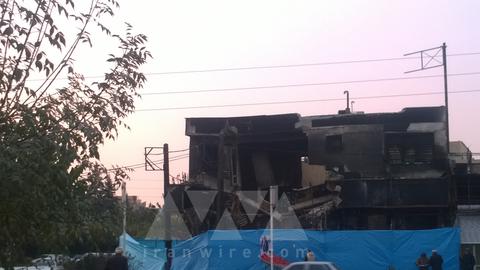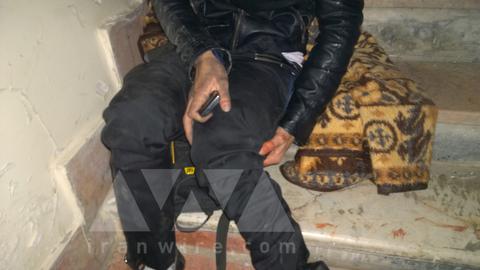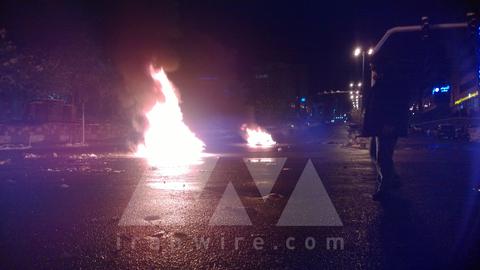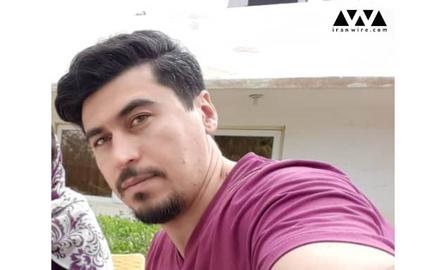The photographs are simply shocking. In one of them a man appears to be looking into the distance, his eyes glassy and lifeless and his face drained of color. “Among the protesters were two medical staff from the hospital,” the photographer tells IranWire. “The man had no blood on him. They said perhaps a sonic weapon exploded next to him and he had a stroke. They tried hard to resuscitate him but it was no use. He died right at my feet.”
Behdad lives in Karaj, a city near Tehran. At the height of the November protests following the steep increase in gas prices he spent two days among the protesters and took numerous photographs and videos. “I was in Tehran’s Jannat Abad neighborhood on November 16 and in the Golshahr district of Karaj on November 17,” he tells IranWire. “I tried to record the events I was witnessing. There were many clashes. Golshahr’s 45-Meter Avenue was taken over by protesters from top to bottom and, of course, they were under constant attack by the security agents.”
Behdad shows me the location of the Karaj clashes on a map. “This is the lowest point of Golshahr 45-Meter Avenue and this other location is the southernmost point of the avenue where it ends,” he says. “This is where the protests were at their strongest. The people had blocked the expressway at this point. When you go a little further down from this point, you reach [the housing development] Phase 4 of Mehr Shahr. The clashes continued here. There was no precedent for this because I do not remember any demonstrations here in recent years. This is where they shot Pouya Bakhtiari.”
According to Behdad, a little further down the boulevard, near where the clashes took place, there is a clinic: “They brought many of the wounded to this clinic. Pouya Bakhtiari and Ameneh Shahbazi, who was shot in the head, were brought here too.”
On the morning of November 16 he was going to Tehran and says that, because of the traffic and the fact that the expressway was blocked, people were driving their cars into Phase 4 of Mehr Shahr because it was parallel to the expressway. “I was going to Golshahr’s metro station when I crossed this area. People had turned off their cars and all the streets were blocked.”
“On November 16 I was mostly stuck in traffic in Tehran,” says Behdad. “On that day there were clashes between people and the police in the neighborhoods of Sadeghieh and Jannat Abad. In this picture I took, two motorcycles are lying on the street after having been set on fire by the people, but before they did that, they [police and security forces] had sprayed a lot of teargas at the people. You could not see anything around you. The street was blocked and the people were relentlessly attacked by the police and security forces. The crowd was eventually dispersed. I got back to Karaj with difficulty and came face to face with a burned and destroyed landscape.”
“On the first crossroad on this street, known as Golzar Crossroad, there is branch of Bank Mellat, its central branch for Karaj,” he says. “The clashes got to this area and they shot at people from the rooftop of the bank building. My friends say that several people were killed and injured here.”
According to Behdad, on November 17 there were so many police and security agents amassed in Golshahr 45-Meter Avenue up to the Golzar Crossroad that no protests were able to take place in that stretch, whereas the day before, the area was completely blocked, packed with people protesting. Despite protests not going ahead in the 45-Meter Avenue area, they continued from the Golzar Crossroads. “That night we had blocked the entries and exits of the alleyways in the area with trash cans, guardrails, charity drop boxes and things like that,” says Behdad. “Our crowd was scattered and the internet was cut off, but people were still out.”
Prison or Amputation?
Behdad gives explanations about the pictures and the videos that he has taken, occasionally pausing when his voice begins to break up. “This wounded person sitting on the steps lived in the Hesarak suburb of Karaj. He was shot in the knee from behind. The same two medics who were among us and had taken shelter in the same house were telling him that he needed immediate surgery; otherwise, his leg would have to be amputated. But he was afraid that he would be arrested at the hospital. ‘Don’t you think it is better to go to prison than to have an amputation?’ I told him.”
Another picture is of a man carrying another young man, unconscious with his head bandaged in white cloth. “I believe he was called Yousef,” says Behdad. “They were targeting us with lasers to shoot at us when this young man came toward us and suddenly fell down. I called my friend to come and help. No matter how many times I called [Yousef] he would not answer. My friend picked him up and we went toward the metro. Many cars and taxies were parked there but they refused to take him to the hospital. One of them even pulled a knife on me and said they would not take him to the hospital. After a lot of difficulty, we did find a car to take him to the hospital. It seemed that he had been bashed on the head with a heavy strike of a baton because even though he had a pulse he showed no other signs of life.”
Then he spoke about what it was like hiding from the security and police forces, and showed IranWire a photograph of homes that people had offered up to protesters to protect themselves. “In the last minutes, we were hiding in this alley,” Behdad says. “They were breaking the windows of homes that had given people shelter. Each time that they attacked, some of us escaped and our numbers became smaller. In the final moments, around 15 of us were gathered here so that security agents could not get us.”
“I was hiding with two friends in a house in one of the dead-end alleys that intersect the 45-Meter Avenue,” he says. “Suddenly we heard the voice of an agent outside who was saying he had identified one of the houses where people were hiding. Then he left. I told my friends that we should go to the roof from where we could perhaps find an escape route. So we went to the rooftop. From a distance I could see the entrance to the alley. Plainclothes agents with flashlights were standing in front of a house where somebody like us had taken refuge. We had no other choice but wait it out.”
Behdad also talked to us about the many banks in Karaj that were destroyed during the protests, a situation other eyewitnesses had told IranWire about earlier: “This is Karaj’s Bank Saderat in Golshahr 45-Meter Avenue,” he says, showing us a photograph. “The video and the picture were taken on November 16. The remains of the bank have since been removed by a loader. They worked 24 hours a day to clear out several banks so that no sign of them would remain. Here, the agents surrounded the building for a few days to prevent anybody from entering.”
He shows us another photograph and says: “In the first days of the protests, overnight and very quickly, they welded iron plates to the outside walls of the bank. They even welded iron bars over the ATMs and put a lock on them at night.”
“This bank,” he says after a pause, “is exactly on the opposite side of the clinic where they took Pouya Bakhtiari after he was shot.”
Behdad also tells IranWire about the security agents and the paramilitary Basijis who were sent to remove notices of mourning ceremonies for those killed during protests. “They removed all notices across the city,” he says. “They threatened many to force them to remove pictures, banners and mourning notices, or even to prevent them from printing them. An important point that I want to make is that in the 2017-2018 protests they also quickly repaired whatever had been damaged. Now they are quickly fixing the banks that were set on fire or removing their remains completely. It is their way of wiping out any memory of protests or protesters. But, under normal conditions, when the roads or buildings need repairs they ignore it forever.”
“I wish I could have taken pictures and videos from everything that happened, but sometimes it was not possible,” Behdad says at the end of our conversation. “But I must say this: none of us are feeling good.”
Related Coverage:
You've Killed My Brother. Now just Leave us Alone and Let us Mourn his Death, 14 December 2019
Why Did They Kill my Mother?, 13 December 2019
Official Claims Mahshahr Protesters Were Armed, 12 December 2019
He was Unemployed. He Loved Freedom. They Killed him..., 10 December 2019
They’ve Killed My Brother. I Want Revenge, 6 December 2019
They Shot Him in the Heart. His Baby is Still Waiting for Him..., 5 December 2019
They Shot him in the Back. He Fought for his Life for 34 Hours. He Lost..., 4 December 2019
Heavy Machine Guns Used to Kill Protesters, 2 December 2019
Security Forces Abandoned his Body Outside the Morgue — After 5 Days, 1 December 2019
Security Forces Kill a 13-Year-Old Bystander, 26 November 2019
She was Helping the Injured When They Killed Her, 25 November 2019
visit the accountability section
In this section of Iran Wire, you can contact the officials and launch your campaign for various problems





























comments